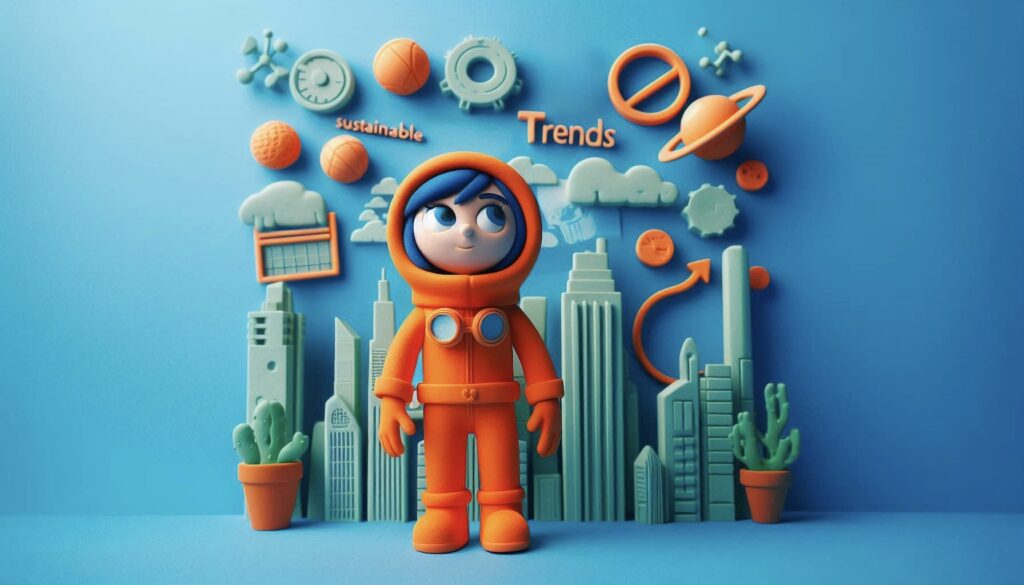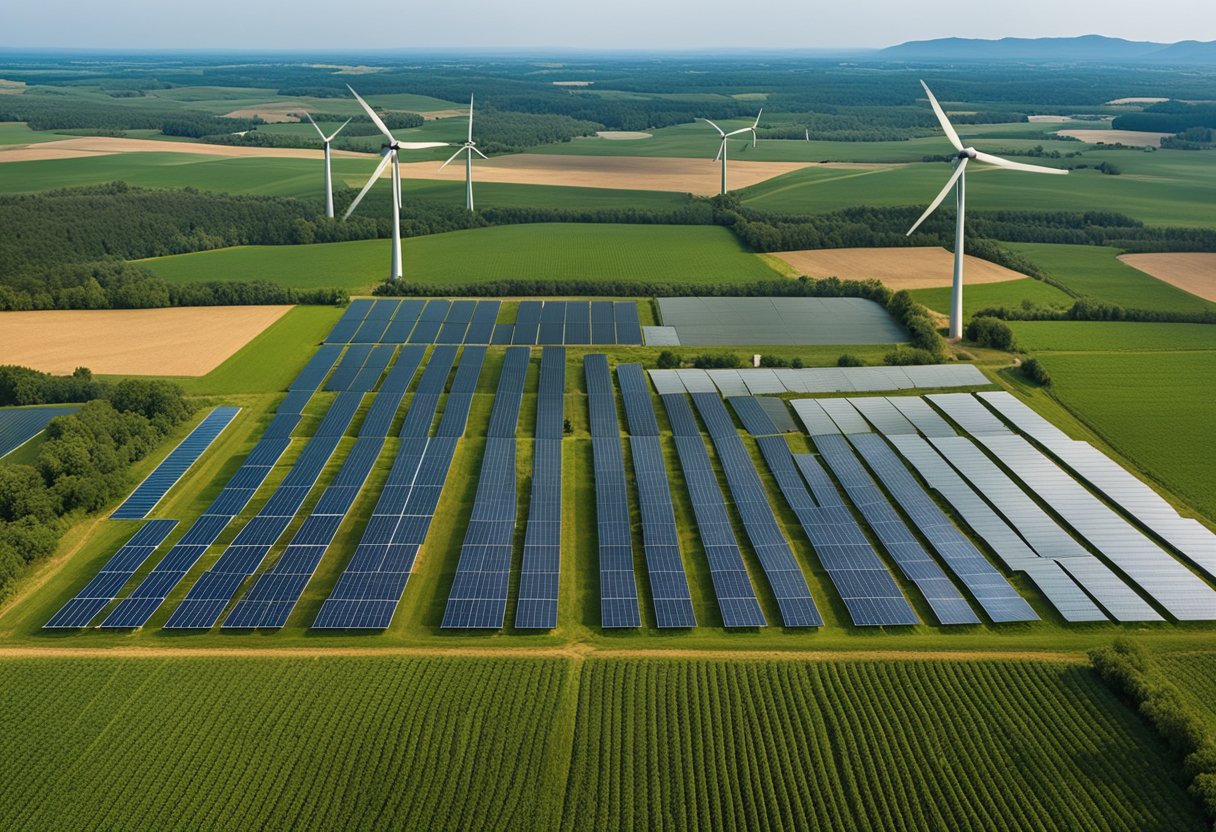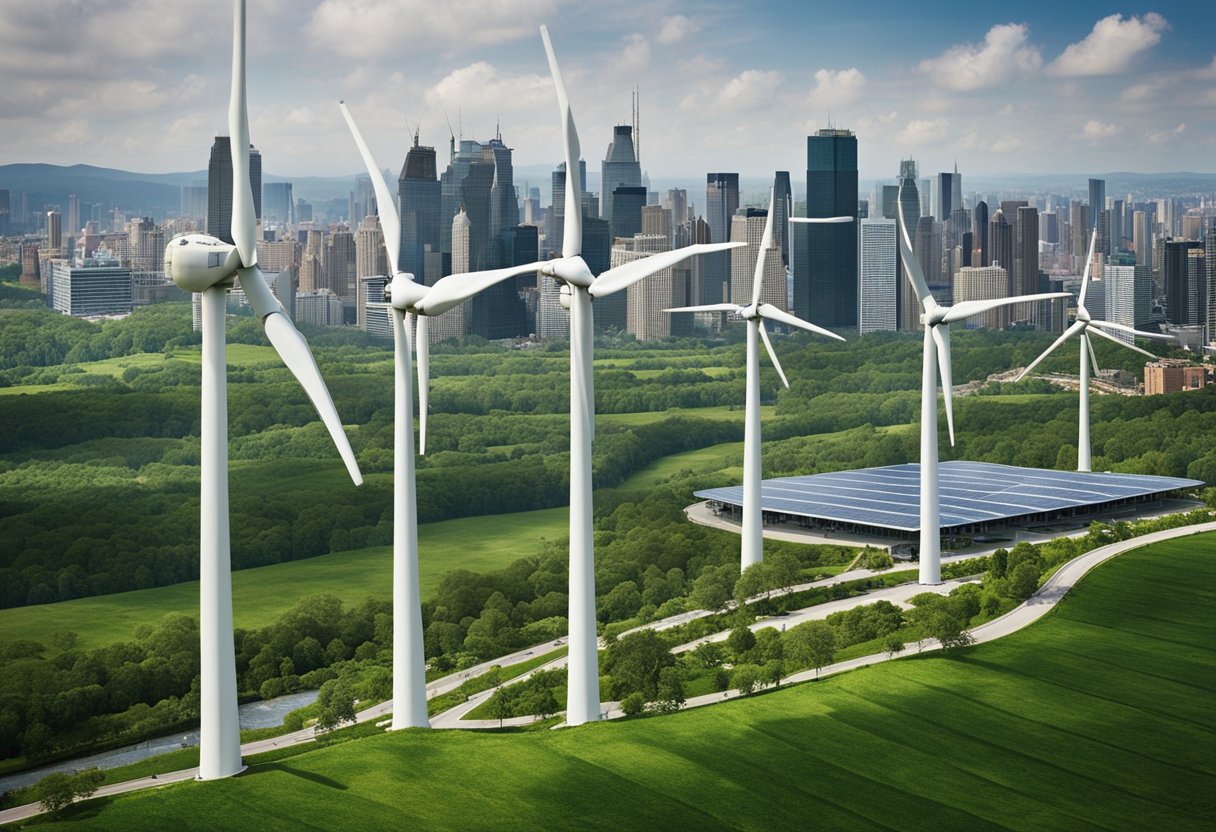The year 2025 marks a pivotal point in the field of sustainability, highlighting advancements and challenges in eco-friendly practices. Various sectors are beginning to recognize the importance of adopting sustainable strategies to not only protect the planet but also to drive economic growth. Understanding these trends can help industries adapt and thrive in an ever-changing global landscape.

From the rise of sustainable finance to the enhancement of infrastructure resiliency, these trends play a crucial role in shaping future business practices. As industries continue to evolve, their strategies will need to align more closely with efforts to address climate change and promote sustainability. This period offers a unique opportunity for innovation and collaboration across different sectors.
1. Circular Economy Initiatives
Circular economy initiatives are gaining traction as a key trend in 2025. These initiatives focus on reducing waste and maximizing the use of resources. By rethinking product lifecycle, businesses aim to create systems where resources are reused and recycled rather than discarded.
Companies are developing new methods to improve product durability and recyclability. This involves designing products with standardized parts for easy disassembly and recycling. Examples include electronics with modular components that extend their working life.
Another aspect of circular economy initiatives is the emphasis on sustainable materials. Many are exploring biodegradable materials and alternatives to traditional plastics. These efforts aim to lessen environmental impact and promote regeneration of natural systems.
Increased collaboration between industries is also pivotal. Sharing resources and information helps reduce waste. For instance, excess materials from one industry can become the raw materials for another, enhancing overall efficiency.
These efforts are further supported by sustainability reporting and regulations. Companies are increasingly held accountable for their environmental impact, encouraging the adoption of circular practices. This trend aligns with broader goals of reducing carbon emissions and conserving natural resources.
2. Regenerative Agriculture Practices

Regenerative agriculture focuses on improving soil health. It uses methods that increase soil organic matter and promote beneficial microbes. These practices make soil more resilient to extreme weather like droughts and heavy rain, which is crucial in tackling climate change.
This approach revives old farming techniques. Farmers use crop rotation and cover cropping to enhance the nutrients in the soil. This not only helps crops grow better but also reduces the need for chemical fertilizers.
Healthy soils can store large amounts of carbon, reducing greenhouse gases in the atmosphere. This makes regenerative agriculture a key player in climate action efforts. These methods also improve water retention, which makes farms more sustainable and productive.
Adopting regenerative agriculture requires teamwork among farmers, researchers, and policymakers. Working together, they can create solutions that both meet food needs and protect the environment. Partnerships like these are vital in promoting sustainable agriculture practices.
Overall, regenerative practices are gaining attention for their potential to create a more sustainable future. As the global focus shifts toward sustainable development, these practices are expected to play a larger role in agriculture. More information about this approach can be found in the article on regenerative agriculture.
3. Carbon Offset Programs
Carbon offset programs are becoming more essential as businesses strive to reduce their environmental impact. These programs allow companies to invest in environmental projects that balance out their carbon emissions. By doing so, organizations can achieve carbon neutrality without eliminating their emissions.
Projects involved in carbon offsetting often focus on renewable energy, reforestation, or energy efficiency. For instance, investing in wind farms or solar power can help replace fossil fuel energy sources. Reforestation projects contribute by absorbing carbon dioxide from the atmosphere.
The demand for carbon offsets is growing, as regulations tighten and consumers become more environmentally conscious. This makes carbon offset programs an attractive option for businesses aiming to improve their sustainability credentials. They are seen as a viable way to address emissions that are tough to eliminate.
Critics argue that offset programs might let companies avoid direct emission reductions. Despite this criticism, these programs provide a practical approach for organizations to contribute positively to ecological balance while working on reducing their own carbon footprints. They serve as a bridge to achieving long-term sustainability goals and can be integrated into broader environmental strategies.
4. Sustainable Fashion Innovations
In 2025, sustainable fashion is leading the industry with creative approaches. A key development is the use of upcycled materials, which transform waste into stylish goods. This reduces landfill waste and gives new life to old materials.
Plant-dyed fabrics are another innovation. These dyes are made from natural sources like plants and flowers. They are eco-friendly, creating less pollution than traditional dyes.
Smart technology is revolutionizing the way clothes are made. With 3D printing, fashion designers can create custom pieces with minimal waste. This technology allows for precise design, reducing fabric scraps.
Circular fashion models are gaining traction. Brands are now designing clothes that can be easily recycled or composted. This approach helps reduce the environmental impact of fashion production.
Transparency and ethical supply chains are in demand. Many consumers want to know their clothes are made fairly. Brands are responding by providing more information about their processes and workers.
For more insights, you can check sustainable fashion trends in 2025 or explore sustainable fashion innovations for a detailed overview.
5. Green Building Technologies
Green building technologies are rapidly advancing in 2025. These innovations focus on reducing energy consumption and increasing efficiency. Many buildings now integrate smart systems that help monitor and control energy use, contributing to environmental sustainability.
One significant trend is the use of sustainable materials. These include recycled and renewable resources, which help decrease the ecological footprint of construction projects. The emphasis is on materials that are both durable and environmentally friendly.
Energy efficiency is another important aspect of green building. Techniques such as improved insulation and solar panel installation are becoming more common. These methods not only reduce energy demand but also promote cost savings in the long term.
Building designs are increasingly focusing on adaptability and climate resilience. This means constructing structures that can withstand extreme weather conditions, which is crucial as climate challenges persist. These designs often incorporate elements like advanced drainage systems and wind-resistant materials.
Additionally, there is a growing emphasis on circular economy practices in construction. This involves reducing waste and reusing materials, which aligns with global sustainability goals. By adopting these practices, the building industry is moving towards a more sustainable future.
Enhanced green building technologies not only benefit the environment but also provide economic advantages. They help cut down on utility costs and increase property value, making them a wise investment for developers.
6. Electric Vehicle Advancements
Electric vehicles (EVs) are experiencing a significant rise in popularity in 2025. The improvements in battery technology are a key factor. Enhanced energy density leads to longer driving ranges, making EVs more practical for consumers.
Infrastructure plays a crucial role in this growth as well. More charging stations are popping up, reducing range anxiety for drivers. This wider network supports the daily needs of EV users more effectively.
EVs are also becoming more affordable. As production scales up and technology matures, the cost of manufacturing is decreasing. This makes EVs accessible to a broader market segment.
Manufacturers are introducing models with better features and designs. They are meeting diverse consumer preferences with options that appeal to varying tastes and lifestyles. This diversity in offerings supports wider adoption.
Government policies worldwide are supporting the EV boom. Many places implement incentives and regulations favoring electric vehicles. These measures encourage consumers and companies to invest in green transportation options.
Emerging technologies like autonomous driving are being integrated with EVs. This not only enhances their appeal but also represents a step forward in futuristic transportation solutions. The intersection of these trends is pushing the electric vehicle industry into an exciting new era.
7. Renewable Energy Solutions

Renewable energy is making significant strides in 2025. Solar and wind power continue to be at the forefront, driven by technological advances. Improved solar panel efficiency and cost reductions are leading to broader adoption.
Wind energy is benefiting from enhanced turbine designs and offshore installations. This is helping generate more power while reducing land use. Such advancements make renewable energy a more viable option for many regions.
Innovation in energy storage is also key. Better battery technologies are addressing the intermittent nature of renewables. This ensures a steady supply of energy even when the sun isn’t shining or the wind isn’t blowing.
The integration of AI and smart grids is revolutionizing how energy is distributed. These systems manage energy flow more efficiently, adapting to consumption patterns in real time. This not only optimizes use but also reduces waste.
Governments and companies are investing heavily in renewable infrastructure. Policies and incentives are encouraging this shift. The aim is to reduce carbon footprints and meet global climate goals through these renewable energy trends.
Overall, these efforts are paving the way for cleaner, greener energy solutions, making them more accessible and sustainable for future generations.
8. Water Conservation Technologies
Water conservation technologies are becoming increasingly crucial in 2025. With growing water scarcity, these technologies focus on sustainable use and management. Innovations are aimed at reducing water waste and improving efficiency across various sectors.
One notable development is the emergence of smart irrigation systems. These systems use sensors and data analytics to optimize water use in agriculture, ensuring that crops receive just the right amount of water needed, reducing waste significantly.
In urban settings, greywater recycling systems are gaining popularity. These systems treat and reuse water from sinks, showers, and laundry for purposes like irrigation and flushing toilets. This reduces the demand for freshwater supplies and promotes sustainable urban living.
Desalination technologies are also being improved. Advances in energy efficiency and cost reduction are making it more viable to convert seawater to freshwater, providing new water sources for regions facing drought.
In addition, rainwater harvesting systems are being implemented more widely. These systems capture and store rainwater for later use, providing a sustainable source of water for both residential and industrial applications.
Overall, these technologies provide creative solutions to address global water challenges.
9. Zero-Waste Packaging
Zero-waste packaging is gaining attention in 2025. The focus is on creating packaging that produces no waste. Manufacturers are rethinking how products are packaged from the start.
This trend involves using materials that can be fully recycled or composted. Many companies aim to design packaging that leaves a minimal footprint. It’s about finding ways to eliminate waste entirely.
Businesses are investing in innovative solutions. These include using biodegradable materials and designing for reuse. The goal is to reduce the overall environmental impact.
Consumers are also playing a role. They demand packaging that aligns with sustainable values. This demand is pushing brands to adopt zero-waste practices. This movement supports a healthier planet by reducing landfill waste and encouraging responsible resource use.
10. Innovations in Renewable Energy
In 2025, renewable energy innovations will continue to focus on improving efficiency and expanding capabilities. Significant advancements in solar technology alongside a surge in wind energy development highlight important trends shaping the sustainable future of energy.
Advancements in Solar Technology
Perovskite solar cells are at the forefront of solar innovation. These cells promise higher efficiency and lower costs compared to traditional silicon-based cells. Researchers are working to overcome stability and durability challenges, making these cells commercially viable.
Offshore solar farms are gaining traction, especially in regions with limited land availability. These floating panels offer new opportunities for solar energy generation, tapping into unutilized bodies of water. They benefit from cooler surface temperatures, which can increase efficiency.
Solid-state batteries play a crucial role by providing better energy storage solutions. They store energy more efficiently, making solar power more reliable even with fluctuating sunlight levels. This innovation is crucial for integrating solar power into the grid without compromising stability.
Growth in Wind Energy
Wind energy is expanding with the development of larger and more efficient offshore wind platforms. These platforms capture stronger and more consistent winds, which enables higher energy generation. Floating turbines are becoming more prevalent, allowing installations in deeper waters where traditional turbines cannot reach.
Smart grid integration is another key area of growth. By incorporating advanced data analytics, wind energy systems can optimize generation and load balancing. This integration enhances reliability and reduces waste, making wind energy more sustainable.
Hybrid systems that combine wind with solar or other renewable sources are also emerging. These systems leverage the strengths of different energy sources, ensuring a more stable and consistent power supply. This approach maximizes renewable energy usage and decreases dependency on non-renewable energy sources.
Sustainable Urban Development
In 2025, cities will focus on developing smarter infrastructure and buildings to address the growing need for sustainability. These efforts will require innovative approaches such as developing smart city technologies and using eco-friendly materials and practices in construction.
Smart Cities and Infrastructure
Smart cities integrate technology to improve quality of life and reduce environmental impact. By using sensors and data analytics, cities can optimize traffic flow, energy usage, and waste management. For instance, smart traffic systems can reduce congestion and emissions by adjusting traffic lights based on real-time conditions. Additionally, smart grids help manage electricity distribution efficiently, matching supply with demand.
Many cities are investing heavily in digital infrastructure to support these goals. This includes widespread 5G networks that enable advanced monitoring and control systems. Smart street lighting, which adjusts brightness based on activity, conserves energy while enhancing safety. These technologies promote resource efficiency, making cities more resilient and sustainable.
Green Building Practices
Green building practices focus on reducing environmental impact during construction and throughout a building’s lifecycle. Techniques such as using sustainable materials, improving energy efficiency, and managing water resources are key components. Builders might choose recycled or locally sourced materials to cut down on carbon footprints.
Energy efficiency involves installing better insulation, energy-efficient windows, and smart heating and cooling systems. These improvements lower energy consumption, reducing costs and emissions. Water-saving technologies like rainwater harvesting and low-flow fixtures help manage water use responsibly.
Certifications such as LEED (Leadership in Energy and Environmental Design) encourage developers to adopt these practices. By focusing on sustainability from design to construction, buildings can become a vital part of urban ecological balance. Emphasizing sustainable materials and energy efficiency ensures that urban areas grow responsibly.
Frequently Asked Questions
In 2025, various advancements and practices are shaping sustainability efforts across industries. These include developments in the circular economy, new sustainable technologies, policy impacts, and the influence of consumer behavior. Below are answers to common questions about these topics.
How will the circular economy concept evolve by 2025?
By 2025, the circular economy focuses on reducing waste and reusing materials across different industries. Many companies are implementing strategies that emphasize recycling, upcycling, and product life extension. CircularEconomyInitiatives have become integral in reducing environmental impact and fostering sustainable growth.
What are the dominant sustainable technologies emerging in 2025?
Emerging technologies in 2025 include advanced energy storage systems, carbon capture, and sustainable materials. Innovations like green building technologies and sustainable fashion designs are gaining traction. These technologies aim to reduce resource consumption and lower carbon footprints across various sectors.
Which industries are leading the way in sustainability practices?
The fashion, agriculture, and construction industries are at the forefront of sustainability. SustainableFashionInnovations promote eco-friendly production methods, while RegenerativeAgriculturePractices focus on enhancing soil health and biodiversity. In construction, GreenBuildingTechnologies have transformed how buildings are designed and operated.
How have governmental policies impacted sustainability trends?
Government policies in 2025 have significantly influenced sustainability trends by setting ambitious targets and regulations. These policies encourage cleaner energy use and promote CarbonOffsetPrograms to reduce emissions. Support for research and innovation in sustainable practices has also been a key focus.
What role has consumer behavior played in shaping sustainability efforts?
Consumer behavior plays a crucial role in driving demand for sustainable products and practices. Shoppers are increasingly choosing eco-friendly options, which compels companies to adopt sustainable methods. This shift has encouraged industries to focus on transparency and environmental responsibility.
What are the key factors driving businesses toward sustainability?
Key catalysts for businesses include regulatory pressures, consumer demand, and the need for resource efficiency. Companies recognize the long-term financial benefits of adopting sustainable practices. These factors, combined with technological advancements, are pushing businesses toward more sustainable models.


